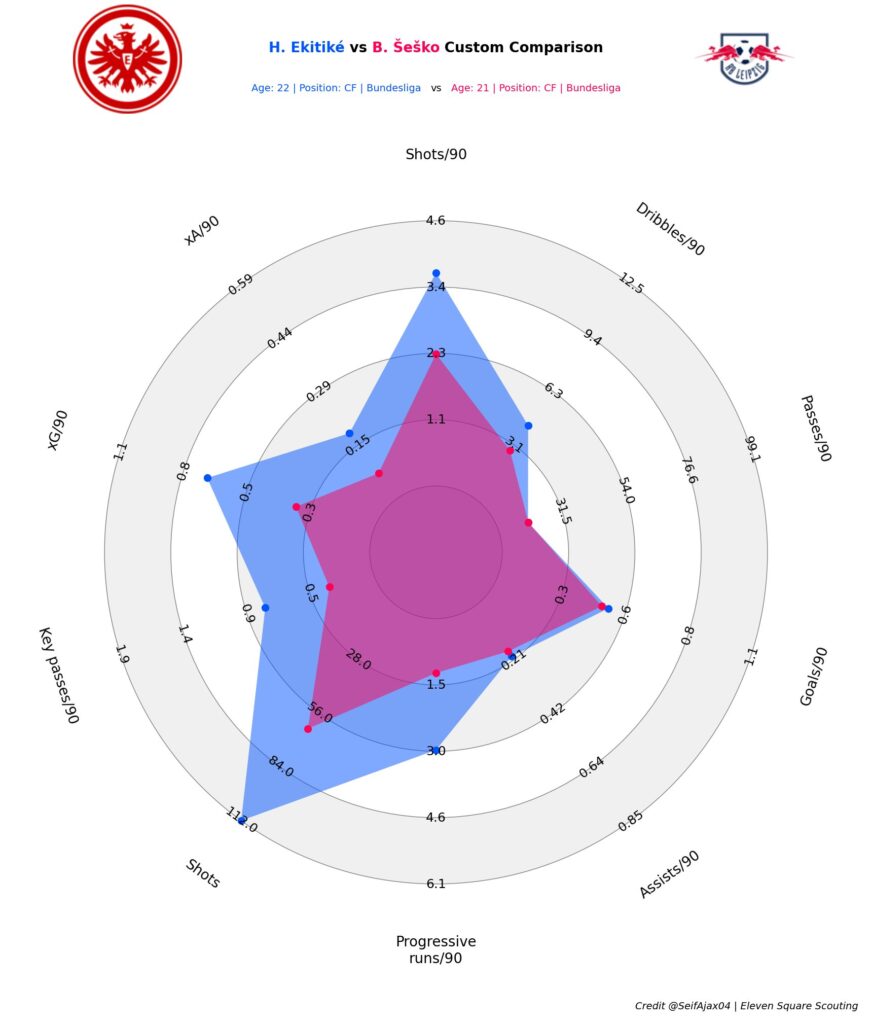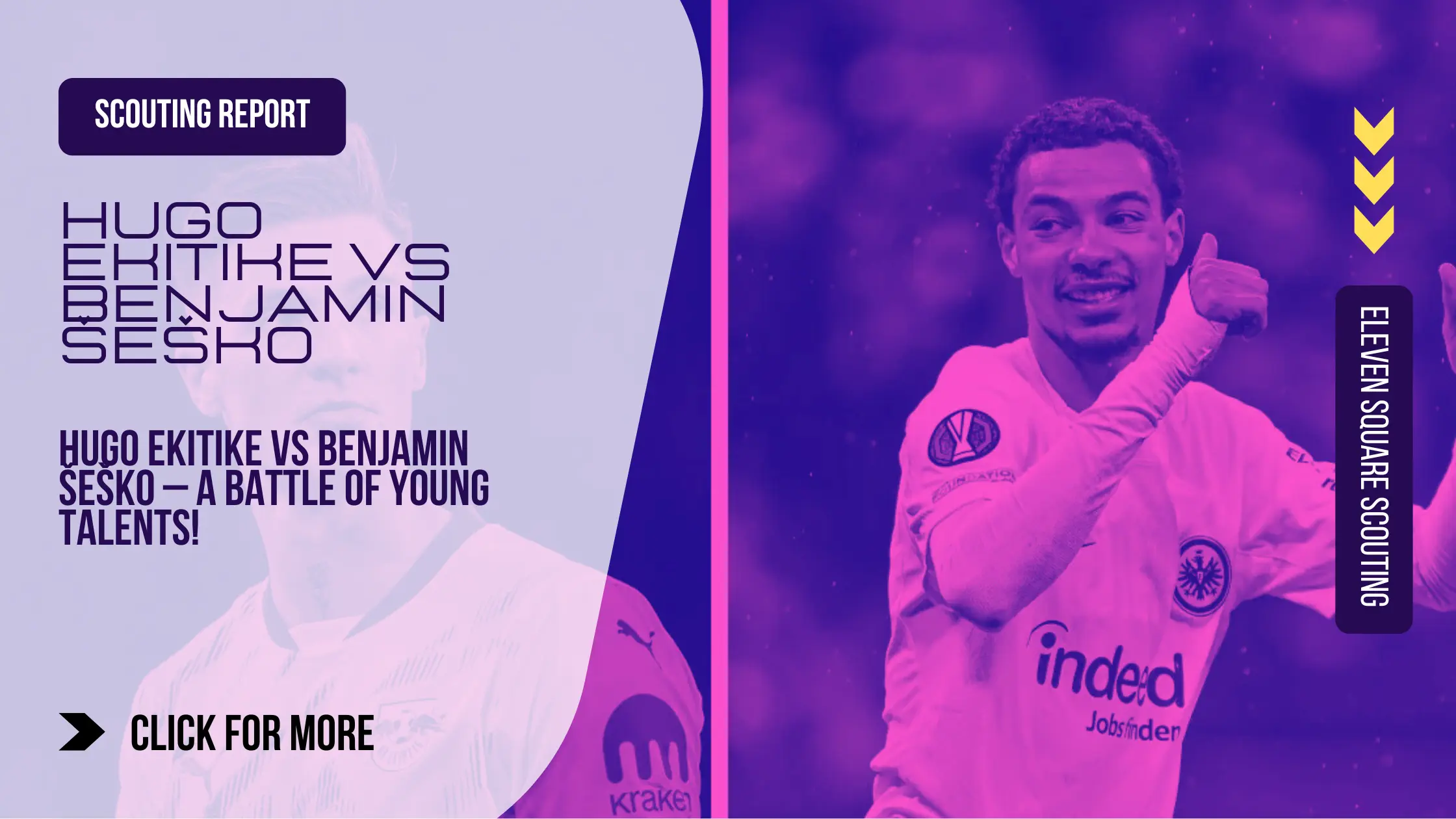Clash of the Bundesliga’s Future: Hugo Ekitike vs. Benjamin Šeško – A Statistical Showdown
The German Bundesliga has long been a breeding ground for Europe’s elite young talent, and the 2024/25 season has been no exception. Two of the brightest emerging strikers, Eintracht Frankfurt’s Hugo Ekitike (21) and RB Leipzig’s Benjamin Šeško (22), have captivated audiences with their skill and goalscoring prowess. With both players having completed 33 matches, their statistics provide a fascinating tale of the tape, revealing two distinct but equally potent attacking profiles.

The Goalscoring Instinct: Volume vs. Efficiency
At first glance, the two forwards appear remarkably similar in their primary duty: putting the ball in the net. Ekitike’s 15 goals and Šeško’s 13 goals (translating to 0.49 vs 0.46 goals per 90 minutes) show that both are consistent threats. However, the underlying numbers reveal a stark contrast in their approach.
Ekitike is a high-volume shooter, relentlessly attacking the goal. He amassed a staggering 112 total shots, averaging 3.68 shots per 90 minutes. This aggressive mentality is further reflected in his Expected Goals (xG) rating of 0.69 per 90, suggesting he consistently gets into high-quality scoring positions.
Šeško, on the other hand, is a more economical striker. He took significantly fewer shots (64 total, 2.28 per 90) and consequently had a lower xG of 0.32. This suggests that while Ekitike actively creates a high quantity of chances, Šeško is more selective, converting fewer opportunities into a nearly identical goal tally.
The Creative Spark and Dribbling Prowess
Beyond goalscoring, a modern striker’s ability to create for others and themselves is crucial. Here, Ekitike demonstrates a significant advantage. While their direct assist numbers are almost identical (0.20 vs 0.18 per 90), Ekitike’s creative potential runs deeper.
His Expected Assists (xA) of 0.18 is more than double Šeško’s 0.07, indicating the chances he creates for teammates are of a much higher quality. This is backed up by his 0.79 key passes per 90 compared to Šeško’s 0.32.
Furthermore, Ekitike is a far more dynamic and aggressive ball-carrier. He attempts 4.27 dribbles per 90 minutes, showcasing a desire to take on defenders one-on-one. Šeško’s 2.81 dribbles are respectable but paint the picture of a less individualistic player.
All-Around Involvement and Movement
When it comes to linking play, both strikers are surprisingly similar in their passing frequency, with Ekitike at 19.35 passes per 90 and Šeško at 19.45. However, their movement tells a different story.
Ekitike is far more involved in driving the ball up the pitch, registering an impressive 3.02 progressive runs per 90. This is more than double Šeško’s 1.25, highlighting Ekitike’s role as a dynamic force who carries the ball from deeper areas to initiate attacks.
Conclusion: Two Paths to the Top
The statistics from the 2024/25 season paint a clear picture of two different but equally effective young strikers.
Hugo Ekitike is the all-action, high-volume forward. He is an engine of offensive production, excelling in creating his own shot, dribbling past defenders, and generating high-quality chances for his team through his dynamic movement and passing.
Benjamin Šeško embodies the efficient finisher. With lower involvement in the creative and build-up phases, he focuses on being in the right place at the right time, demonstrating a clinical edge to convert his chances at a rate that keeps him level with his more dynamic counterpart.
While Šeško represents clinical efficiency, Ekitike embodies relentless dynamism. The Bundesliga is fortunate to feature both, and their contrasting styles will make their continued development a thrilling narrative for football fans to follow.
Note: All data and statistics presented in this article are sourced from the Eleven Square Scouting Dashboard application.


Published by